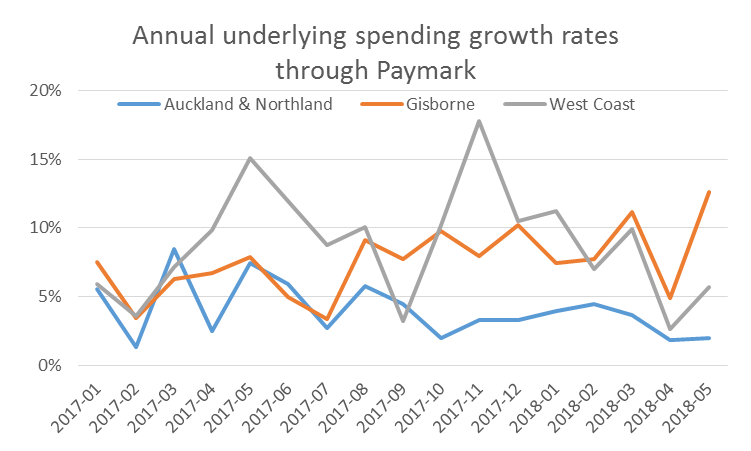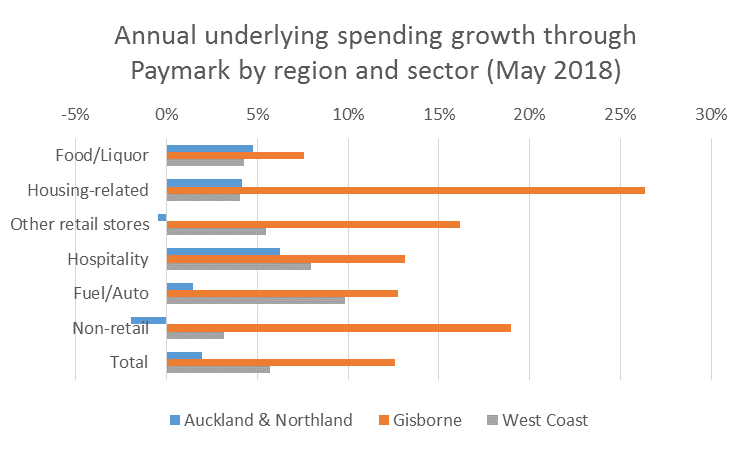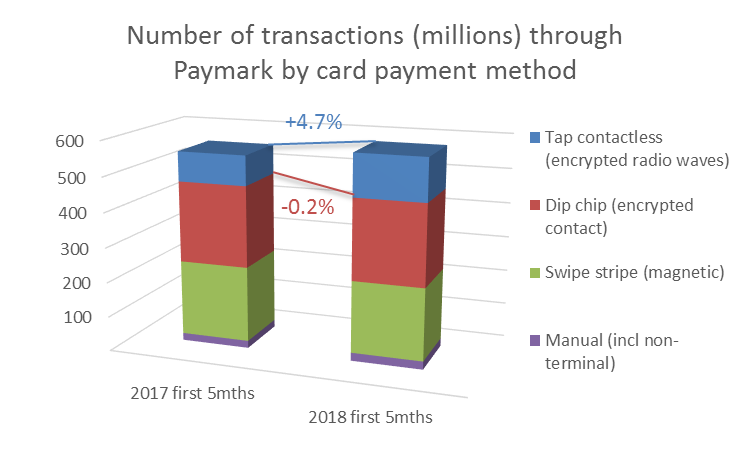Monthly economic data from Paymark: Tapping out
Tapping out
Wednesday 6 June, 2018
Paymark processed nearly 109 million transactions in May. These transactions reveal information about the economy, and about our behaviour. Two patterns stand out at present: we are embracing the seamless “tap and go“ payments that contactless cards offer but we are also taking a more cautious approach to spending in general.
Contactless payments are growing in popularity and their impact on the card use patterns are starting to be seen in the data.
Spending did pick up in May from the holiday-induced
slowdown of April but the annual growth rate remains modest,
especially in the major urban regions, confirming that
spending has decelerated this year. The month-to-month pick
up shows as a seasonally adjusted 1.0% jump in spending
through Paymark between April and May, following the 1.4%
decline in April. The more telling indicator statistic is
the 4.0% growth rate between May 2017 and May 2018, both
below the 4.8% average of the first four months of the year
and below the 5.4% of 2017.
| PAYMARK All Cards Data (May 2018 versus same month 2017) | ||||
| Volume | Underlying* | Value | Underlying* | |
| Region | transactions millions | Annual % change | transactions $millions | Annual % change |
| Auckland/Northland | 43.96 | 4.9% | $2,086.0 | 2.0% |
| Waikato | 7.98 | 6.4% | $350.7 | 5.0% |
| BOP | 7.01 | 7.7% | $320.1 | 5.4% |
| Gisborne | 1.01 | 10.0% | $43.0 | 12.6% |
| Taranaki | 2.29 | 5.9% | $97.5 | 4.7% |
| Hawke's Bay | 3.18 | 5.6% | $140.9 | 6.0% |
| Wanganui | 1.20 | 10.7% | $48.0 | 10.2% |
| Palmerston North | 3.48 | 8.0% | $169.9 | 10.7% |
| Wairarapa | 1.04 | 9.9% | $45.2 | 10.3% |
| Wellington | 11.76 | 5.8% | $485.4 | 4.1% |
| Nelson | 1.91 | 3.6% | $91.6 | 4.8% |
| Marlborough | 1.18 | 16.1% | $55.7 | 11.1% |
| West Coast | 0.61 | 8.5% | $30.0 | 5.7% |
| Canterbury | 11.91 | 5.8% | $544.9 | 4.1% |
| South Canterbury | 1.55 | 5.6% | $76.0 | 4.9% |
| Otago | 5.88 | 8.2% | $264.7 | 6.0% |
| Southland | 2.25 | 9.7% | $109.7 | 8.6% |
| New Zealand | 108.99 | 6.0% | $5,008.9 | 4.0% |
| * Underlying spending excludes large clients moving to or from Paymark within last 12 months |
Figure 1: Paymark All Cards data (May 2018 versus May 2017)
As has been the case for several months now, the lowest growth rates are occuring in Auckland/Northland (2.0% annual growth in May), Wellington (4.1%) and Canterbury (4.1%). Conversely spending growth is strong amongst the smaller regions such as Gisborne (12.6%), Marlborough (11.1%), Palmerston North (10.7%), Wairarapa (10.3%), Wanganui (10.2%). The smallest of the Paymark regions, West Coast (5.7%), experienced growth between the two extremes.
The Auckland/Northland trend is well-established (see Figure 2) and is likely linked to housing markets. Wellington, Canterbury and Nelson show a similar pattern. Elsewhere the trends are mixed. West Coast is coming off relatively strong growth last year, as are Bay of Plenty, Hawke‘s Bay, Otago, South Canterbury, Southland, Taranaki and Waikato. Conversely growth has generally been stronger of late in Gisborne, as well as in Marlborough, Palmerston North, Wairarapa and Wanganui.

Figure 2: Paymark All Cards data underlying growth on month year earlier for selected regions
Within each region, the
sector spending patterns are mixed (see Figure 3). For
example, Gisborne spending growth in May was evident across
all major sector groupings (although not all merchants and
sub-sectors experienced growth e.g. Gisborne Footwear
spending down 27%). West Coast spending growth was also
general but at a lower average rate. But patterns were more
patchy in Auckland/Northland, with retails sub-sectors such
as clothing, electrical and recreational goods all recording
lower spending in May, as was also the case for Accommdation
(within the Hospitality sector) and amongst non-retail
merchants groupings such as banks, insurance, rental cars,
gyms and providers of travel-related activities. Some of
these patterns appear to reflect strong tourism activity in
Auckland twelve months earlier.

Figure 3: Paymark All Cards data underlying growth for sectors within selected regions (May 2018 versus May 2017)
Irrespective of cyclical patterns across regions and sectors, a growing preference for contactless payments is showing through strongly.
The number of transactions through Paymark dropped in the first five months of this year for the traditional methods of swiping (using the magnetic stripe), dipping (putting the card chip into the terminal) and simply exchanging card details, in total by 0.2%. But total transactions were up 4.7% to almost 600 million. The contactless card increase of 42% has contributed to all the growth in card usage so far this year.
Contactless cards have been slow to catch on in the early stage of their deployment but as more terminals are deployed that can read these cards, and as retailers become more comfortable with the use of contactless cards, the increase in usage is starting to ramp up.

Figure 4: Paymark All Cards data number of transactions by payment mechanism (Jan-May 2018 versus Jan-May 2017)
ENDS


 Stats NZ: Annual Number Of Home Consents Down 7.4 Percent
Stats NZ: Annual Number Of Home Consents Down 7.4 Percent Plains Media: Plains FM Announces Name Change After 37 Years
Plains Media: Plains FM Announces Name Change After 37 Years NIWA: Flooding From Underneath - New Tool Reveals Shallow Groundwater Elevations
NIWA: Flooding From Underneath - New Tool Reveals Shallow Groundwater Elevations Commerce Commission: Commission Concludes Auckland Airport Over-charging By $190 Million
Commerce Commission: Commission Concludes Auckland Airport Over-charging By $190 Million The Future Is Rail: Ferry Decision - Common Sense Prevails
The Future Is Rail: Ferry Decision - Common Sense Prevails Aotearoa Food Rescue Alliance: Grocery Market Reform Must Include Mandatory Food Rescue Partnerships
Aotearoa Food Rescue Alliance: Grocery Market Reform Must Include Mandatory Food Rescue Partnerships



